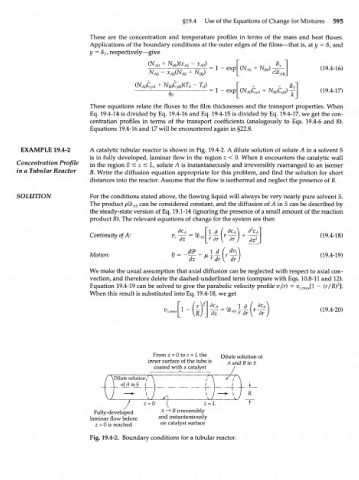Page 615 - Bird R.B. Transport phenomena
P. 615
§19.4 Use of the Equations of Change for Mixtures 595
These are the concentration and temperature profiles in terms of the mass and heat fluxes.
Applications of the boundary conditions at the outer edges of the films—that is, at у = 8 and
X
у ~ 8 respectively—give
T/
(N A *ло)
- x A0 (N A0 + N B0 ) (19.4-16)
{N A0 C C f N B0 C pB )(T 5 - T o )
A 0 p A
exp (19.4-17)
These equations relate the fluxes to the film thicknesses and the transport properties. When
Eq. 19.4-14 is divided by Eq. 19.4-16 and Eq. 19.4-15 is divided by Eq. 19.4-17, we get the con-
centration profiles in terms of the transport coefficients (analogously to Eqs. 19.4-6 and 8).
Equations 19.4-16 and 17 will be encountered again in §22.8.
EXAMPLE 19.4-2 A catalytic tubular reactor is shown in Fig. 19.4-2. A dilute solution of solute Л in a solvent S
is in fully developed, laminar flow in the region z < 0. When it encounters the catalytic wall
Concentration Profile in the region 0 < z < L, solute A is instantaneously and irreversibly rearranged to an isomer
in a Tubular Reactor B. Write the diffusion equation appropriate for this problem, and find the solution for short
distances into the reactor. Assume that the flow is isothermal and neglect the presence of B.
SOLUTION For the conditions stated above, the flowing liquid will always be very nearly pure solvent S.
The product рЯЬ can be considered constant, and the diffusion of A in S can be described by
А5
the steady-state version of Eq. 19.1-14 (ignoring the presence of a small amount of the reaction
product B). The relevant equations of change for the system are then
^ . Ц А (,*)•*?] (19.4-18)
Motion: (19.4-19)
We make the usual assumption that axial diffusion can be neglected with respect to axial con-
vection, and therefore delete the dashed-underlined term (compare with Eqs. 10.8-11 and 12).
2
Equation 19.4-19 can be solved to give the parabolic velocity profile v (r) = ^ zmax [l - (r/R) ].
z
When this result is substituted into Eq. 19.4-18, we get
(19.4-20)
dz dr
From z = 0 to z = L the Dilute solution of
inner surface of the tube is A and В in S
coated with a catalyst
Dilute solution^
ob4in_S_ j _
' I
• — • \
2 = 0 z = L
Fully-developed A —> В irreversibly
laminar flow before and instantaneously
z = 0 is reached on catalyst surface
Fig. 19.4-2. Boundary conditions for a tubular reactor.

